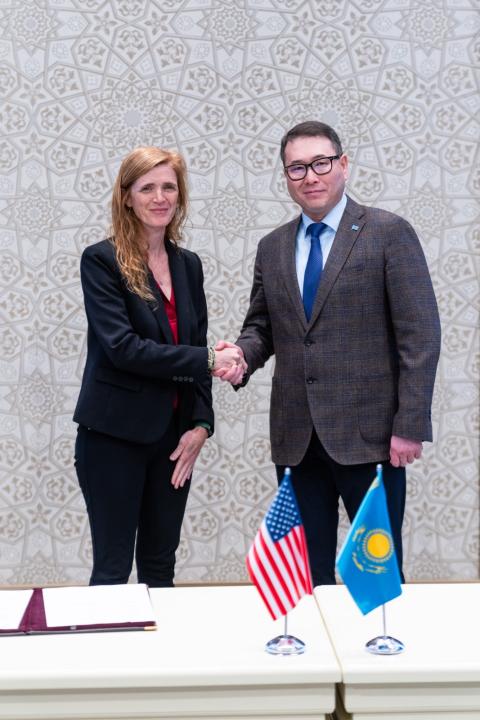ASTANA — The Central Asian region is swiftly emerging as a pivotal link in the global transportation network, establishing itself as a crucial continental bridge connecting North-South and East-West, said the Kazakh Minister of Trade and Integration Arman Shakkaliev during the C5+1 ministerial conference held in Samarkand on Oct. 24, the ministry’s press service reported.

The Central Asian countries increasingly complement each other in ensuring food security, collectively emerging as a food hub for third countries. Photo credit: Ministry of Trade and Integration.
Kazakhstan, in particular, has become a vital transport and logistics hub in Eurasia, boasting 11 international transit routes, including five railways and six roads.
“We are also ready to do our part to protect global supply chain networks. The Central Trans-Caspian Network has been identified as the most sustainable transport network connecting Central Asia with the Trans-European Transport Network. Over the past three years, container traffic along this route has grown more than 13 times,” Shakkaliev said.
Developing the Trans-Caspian route holds immense importance for Kazakhstan as it positions itself as a reliable supplier of energy resources and strategic goods to Europe and global markets, including the US. Shakkaliev highlighted that Kazakhstan’s priorities for expanding its transport and logistics capabilities include plans to establish a “container hub” based on the ports of Aktau and Kuryk and the acquisition of new sea vessels.

Minister Shakkaliev and Samantha Power, the Administrator of the USAID on Oct. 24. Photo credit: Ministry of Trade and Integration.
He affirmed Kazakhstan’s commitment to strengthening its position as a Eurasian transport and logistics center, emphasizing the Central Asian region’s integral role in global logistics. He also expressed the country’s eagerness to further enhance the C5+1 dialogue across various domains, including energy and the environment, economic growth, and peace and stability in Central Asia.
During the C5+1 ministerial conference, Arman Shakkaliev engaged in discussions with Samantha Power, the Administrator of the United States Agency for International Development (USAID). The meeting centered on bilateral and regional cooperation, focusing on digitalization, environmental initiatives, renewable energy, and prospects for the Middle Corridor.
The C5+1 format is the primary diplomatic platform for cooperation between Central Asian countries, including Kazakhstan, the Kyrgyz Republic, Tajikistan, Turkmenistan, and Uzbekistan, in collaboration with the United States (US) government.
The Central Asian region, characterized by rapid population growth dynamics, predominantly comprises a younger generation. These countries increasingly complement each other in ensuring food security, collectively emerging as a food hub for third countries.
In the past year, trade turnover between Kazakhstan and Central Asian nations increased by a quarter, amounting to $7.9 billion. This growth was driven by a substantial increase in Kazakh exports, up by 26.7%, and imports from Central Asian countries, which surged by 23.1%. This upward trend in trade underlines the region’s growing importance as a central player in global trade and connectivity.


